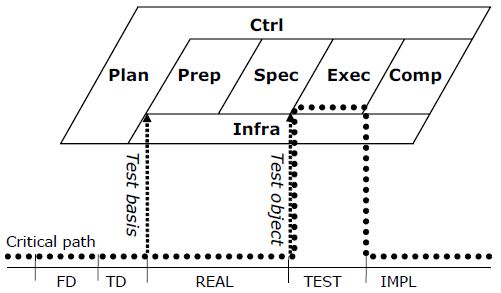Retesting in the TMap life cycle model
The life cycle model also provides space for retesting. Retests occur when defects are detected while executing the
test cases. If a retest must be prepared and executed, it may be necessary to go through some phases of the TMap life
cycle model again. Depending on the situation, this may be limited to the Execution phase, e.g. if only defects in the
software are to be solved. If defects in the test basis must be solved, it may be necessary to (re)plan the retest
completely (in particular in the case of a extensive rework action of the test basis). The phases Preparation,
Specification and Execution must then all be gone through again.
TMap life cycle model in relation to development models
The TMap life cycle model can be applied within various system development models. It does not matter whether system
development occurs on the basis of principles such as waterfall, iterative or increments. The reason is that every
system development model has the system development phasing as shown in figure 1 below. In iterative and
incremental development (e.g. the RUP and DSDM methods), the first development phases in the model (FD, TD and REAL)
must be seen as intermediary products. These are then tested (TEST) and integrated (INT). Figure 2 -
Relationship TMap life cycle with increments shows this schematically.

Figure 1: Relationship between TMap test life cycle and system development life cycle

Figure 2: Relationship TMap life cycle with increments
At the project level, above all increments, the phases Planning, Control and Setting up and maintaining infrastructure
are executed. The phases Planning, Preparation, Specification, Execution and Completion apply for every increment. The
Planning phase in the increments is in close relationship to the master Control phase, hence the open link between the
two. In view of the repetitive nature of iterative and incremental development, we must emphasise the repeatability of
the tests. This can be achieved by e.g. the use of test tools and adequate testware management.
|
